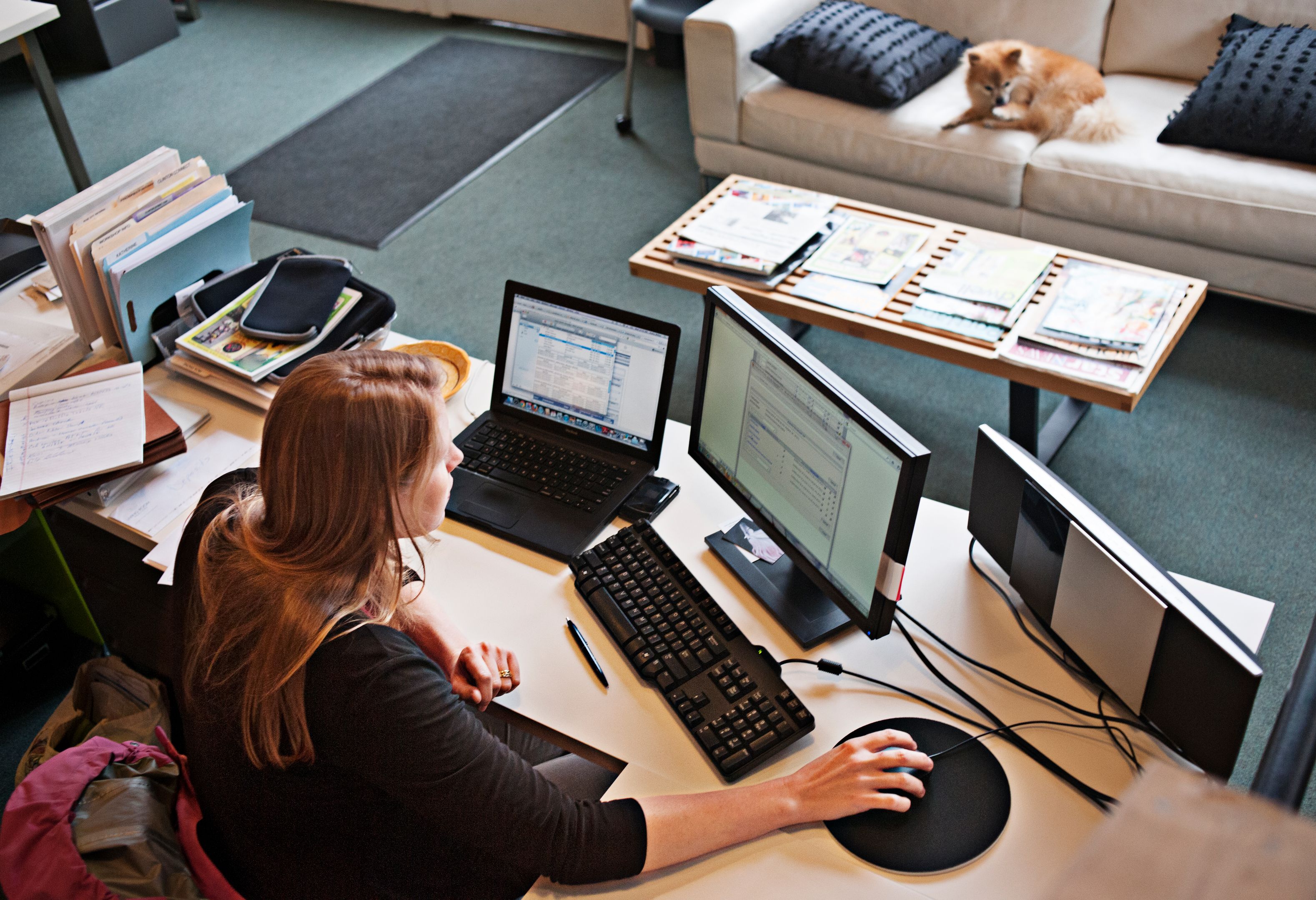Jika Anda pernah mencoba mengirim berkas berukuran besar lewat Gmail—misalnya, video beresolusi tinggi, berkas Photoshop berlapis, atau presentasi berukuran besar—Anda mungkin pernah mengalami batas mengerikan sebesar 25 MB. Dan ketika Anda berhadapan dengan tenggat waktu klien atau mencoba mengirimkan aset akhir yang mendesak, batasan tersebut bukan hanya merepotkan—tetapi juga jalan buntu alur kerja.
Jadi apa yang harus Anda lakukan? Anda mulai mengompres file (dan mengorbankan kualitas), membagi aset ke beberapa email, atau bergulat dengan tautan rusak dan email yang tidak terkirim. Tak satu pun dari hal tersebut yang menunjukkan sifat “profesional”, dan tidak menghemat waktu.
Untungnya, ada cara yang lebih mudah untuk menghindari batasan ukuran file Gmail yang mengganggu itu. Dropbox memberi Anda dua pilihan:
- Bagikan langsung dari penyimpanan awan jika Anda berkolaborasi pada file yang sama
- Gunakan Dropbox Transfer untuk mengirim salinan file yang bersih dan tanpa kompresi
Dalam panduan ini, kami juga akan menjelaskan cara menggunakan perintah Google Drive otomatis di Gmail untuk mengirim file besar, jika Anda tidak khawatir tentang kompresi
Dengan cara apa pun, Anda melewati batas ukuran, mengatasi stres, dan tetap memegang kendali penuh. Ingin mengirim file besar di Gmail dengan cara yang benar? Baca terus untuk melihat betapa mudahnya.

Mengapa berkas saya tidak dapat dilampirkan di Gmail?
Kita semua pernah mengalaminya—Anda mencoba melampirkan file di Gmail, dan tidak terjadi apa-apa. Atau lebih buruk lagi, Anda menekan tombol kirim dan malah mendapat pesan balasan yang tidak menyenangkan. Jadi apa yang terjadi jika file besar Anda tidak dapat dilampirkan atau dikirim di Gmail?
Berikut ini adalah beberapa tersangka yang biasa:
- Terlalu besar: Batas lampiran Gmail hanya 25 MB. Itu bagus untuk tahun 2005, tetapi tidak banyak jika Anda bekerja dengan video, gambar, berkas desain, dan aset besar lainnya. Begitu batasnya tercapai—Anda terjebak.
- Koneksi internet Anda lemah: Koneksi yang tidak stabil dapat mencegah pengunggahan selesai, terutama jika ukuran file besar. Jika WiFi Anda buruk atau agak jauh dari router, pengunggahan dapat dengan mudah gagal.
- Jenis file dibatasi: Gmail memblokir jenis file tertentu (seperti .exe, .kelelawar, atau .zip file) karena alasan keamanan—meskipun file tersebut sama sekali tidak berbahaya. Hal ini menjengkelkan jika Anda bekerja dengan berkas-berkas ini dan berarti Anda akan menemui jalan buntu.
- Kotak surat Anda penuh: Terkadang, jika akun Google Anda hampir mencapai batas penyimpanan, lampiran mungkin tidak terkirim. Ini merupakan masalah khusus bagi pekerja lepas dan wirausahawan tunggal yang mengandalkan versi dasar Gmail.
- Anda menggunakan Gmail versi lama: Ekstensi browser atau Gmail versi lama dapat menyebabkan gangguan fungsionalitas. Orang sering mengalami masalah ini pada perangkat seluler dan tablet yang hanya mereka gunakan untuk mengirim email sesekali.
Jika Anda pernah mengalami masalah saat melampirkan file ke email, Anda tidak sendirian. Ada cara yang lebih mudah untuk mengirim file besar tanpa masalah. Mari kita lihat beberapa pilihan sederhana.
3 cara mengirim file besar melalui Gmail
Jika Anda secara teratur bekerja dengan file besar, lampiran standar Gmail dapat terasa seperti hambatan yang mengganggu alur kerja Anda. Namun, ada beberapa cara cerdas untuk mengirimkan berkas Anda. Mari kita bahas 3 pilihan sederhana:
1. Gunakan Gmail dengan Google Drive
Bila berkas Anda lebih dari 25 MB, Gmail akan menyarankan Anda untuk menggunakan tautan Google Drive. Ini adalah solusi yang tepat—tetapi tidak sempurna. Inilah alasan mengapa Anda harus mempertimbangkan kembali opsi ini sebelum mengirim berkas Anda:
- Drive terkadang mengompres file atau mengonversinya, yang berpotensi menimbulkan beberapa masalah format aneh
- Klien juga dapat secara tidak sengaja mengedit atau mengganti nama file, yang membuat kontrol versi menjadi rumit
Ini sedikit seperti ladang ranjau, tetapi Dropbox membuatnya tetap sederhana. Dengan membiarkan berkas tetap persis seperti saat Anda mengunggahnya—tanpa kompresi, tanpa konversi, tanpa drama.
2. Gunakan Dropbox untuk membagikan tautan yang dapat dilacak
Jika Anda menginginkan lebih banyak kontrol dan keandalan, tanpa mengganggu alur kerja Anda, solusi paling sederhana adalah membagikan file Anda melalui tautan Dropbox. Anda dapat melakukannya langsung dari penyimpanan awan dengan cara berikut:
- Unggah file, laluklik kanan di penyimpanan cloud Anda dan pilih 'Salin tautan'
- Tempel tautan tersebut ke dalam pesan Gmail Anda—tidak perlu dikompres, dizip, atau dibagi
Dengan metode ini, klien mendapatkan akses langsung dan profesional ke berkas tersebut, persis seperti yang Anda inginkan. Dan karena Anda berbagi berkas langsung, Anda dapat memutuskan siapa yang dapat mengedit, melihat, atau mengunduhnya.
Manfaat lainnya mencakup fitur-fitur seperti perlindungan kata sandi, tanggal kedaluwarsa file, dan pelacakan tampilan untuk memberi Anda kontrol dan transparansi penuh, cocok untuk mengelola dan memantau progres suatu proyek.
Tautan bersama sangatlah cocok saat Anda bekerja secara kolaboratif. Tetapi jika Anda ingin mengunci versi final untuk pengiriman, mungkin lebih baik mencoba Transfer sebagai gantinya.
3. Kirim dengan Dropbox Transfer untuk file besar
Ketika produk akhir sudah siap dikirim, gunakan Transfer untuk mengirimkan file berukuran besar yang tidak dapat diedit. Transfer juga dilengkapi keamanan tingkat tinggi. Berikut cara melakukannya dalam beberapa klik saja:
- Cukup kunjungi dropbox.com/transfer
- Unggah file Anda dan kirimkan ke penerima
Metode ini ideal untuk mengirim video, gambar, atau file desain—hingga 100 GB. Tidak ada tekanan ukuran file, tidak ada pengeditan dari penerima, hanya pengalaman pengiriman yang bersih dan dapat diandalkan. Aplikasi ini juga memberi Anda kemampuan mengunggah dan mengunduh dengan cepat.
Transfer juga memudahkan penambahan merek khusus, pengaturan kata sandi, dan pelacakan kapan klien membuka atau mengunduh berkas. Butuh lebih banyak ruang? Tidak masalah, dengan Dropbox Replay Add-On, Anda dapat mengirim file hingga 250 GB.
Ini adalah metode yang tepat bagi fotografer, editor, desainer—siapa pun yang mengirimkan karya yang bagus kepada klien. Baik Anda sedang bekerja dengan tenggat waktu atau hanya tidak ingin mengganggu alur kerja Anda, Transfer memudahkan pengiriman file besar.
Tips untuk hasil yang lebih baik saat mengirim file besar melalui Gmail
Bahkan dengan alat terbaik sekalipun, beberapa kebiasaan cerdas dapat memberikan dampak yang besar. Baik Anda mengirim berkas berukuran besar ke klien atau berkolaborasi di dalamnya, berikut beberapa kiat untuk membuat berbagi berkas lebih lancar dan profesional:
- Tambahkan nomor versi atau tanggal ke nama file—ini membantu Anda atau klien Anda menghindari kebingungan dengan memberi label file dengan jelas
- Bagikan folder, bukan hanya file—Dropbox memungkinkan Anda mengelompokkan file terkait (seperti dokumen pendukung) dalam satu folder agar semuanya tetap rapi dan memudahkan untuk melihat keseluruhannya
- Aktifkan notifikasi atau lacak tampilan—alat seperti Dropbox memungkinkan Anda melacak tampilan dan unduhan, jadi Anda tidak akan pernah bingung atau bertanya-tanya apakah pekerjaan Anda hilang di kotak masuk seseorang.
Trik kecil ini menghemat waktu, mengurangi bolak-balik, dan membuat Anda terlihat sangat terorganisir—karena Anda tidak perlu susah payah mencari file dan merasa frustrasi dengan keterbatasan Gmail.
Pertanyaan yang sering diajukan
Gmail memungkinkan Anda melampirkan file hingga 25 MB. Jika berkas Anda lebih besar, Gmail akan meminta Anda untuk menggunakan Google Drive. Ini berguna, tetapi dapat mengkompres berkas Anda dan memberikan kontrol yang lebih sedikit atas cara berkas Anda diakses.
Anda tidak dapat melampirkan folder langsung ke Gmail. Namun, Anda dapat menggunakan penyimpanan awan di akun Dropbox Anda untuk berbagi tautan ke folder tersebut. Untuk melakukannya, unggah folder Anda, lalu klik kanan dan pilih ‘Salin tautan’ untuk membuat tautan berbagi, kemudian cukup tambahkan tautannya ke email Anda. Jika Anda ingin berbagi kumpulan file, mengunggah folder seringkali lebih cepat dan mudah.
Tidak secara langsung, tetapi ketika Gmail mengalihkan file besar melalui Google Drive, gambar atau video mungkin akan diperkecil agar ukuran file menjadi lebih kecil. Cara ini dapat mengubah kualitas gambar dan video. Alat seperti Dropbox memudahkan Anda berbagi file tanpa kehilangan kualitas.
Anda dapat menggunakan Dropbox untuk berbagi file besar—tanpa batasan ukuran Gmail, Outlook, atau klien email lainnya. Jika Anda perlu mengirim file besar melalui Gmail, Anda cukup mengunggah file ke Dropbox, dapatkan tautan, dan kirim tautan tersebut dalam pesan Gmail. Dengan cara ini, Anda terhindar dari batasan ukuran dan mendapatkan akses ke fitur tambahan seperti kata sandi, tanggal kedaluwarsa, pelacakan berkas, dan banyak lagi.


